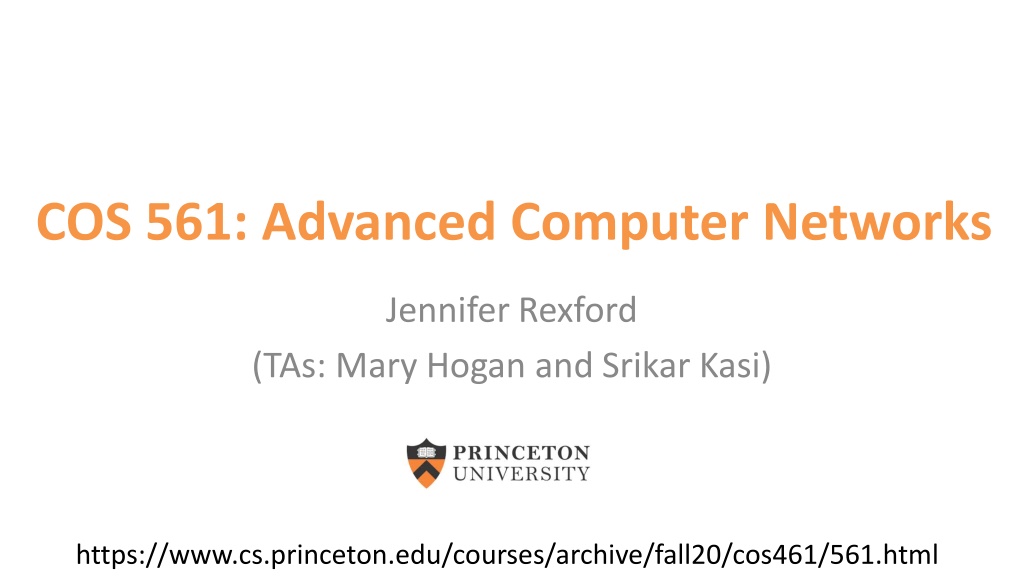
Advanced Computer Networks Overview and Technologies
Explore advanced computer networks covering data plane streaming algorithms, packet forwarding, context for the paper, OpenFlow, protocol-independent switch architectures, and Click modular router. Learn about programmability, high-performance data planes, SDN, and more.
Download Presentation

Please find below an Image/Link to download the presentation.
The content on the website is provided AS IS for your information and personal use only. It may not be sold, licensed, or shared on other websites without obtaining consent from the author. Download presentation by click this link. If you encounter any issues during the download, it is possible that the publisher has removed the file from their server.
E N D
Presentation Transcript
COS 561: Advanced Computer Networks Jennifer Rexford (TAs: Mary Hogan and Srikar Kasi) https://www.cs.princeton.edu/courses/archive/fall20/cos461/561.html
Data Plane Streaming algorithms that act on packets Matching on some bits, taking a simple action at behest of control and management plane Wide range of functionality Forwarding Access control Mapping header fields Traffic monitoring Buffering and marking Shaping and scheduling Deep packet inspection
Packet Forwarding Control plane computes a forwarding table Maps destination address(es) to an output link Handling an incoming packet Match: destination address Action: direct the packet to the chosen output link Switching fabric Directs packet from input link to output link Processor Switching Fabric
Context for the Paper Programmability Active networks (mid-to-late 1990s) Software-Defined Networking High-performance data planes Operating system FPGAs and Network Processors ASICs Prototyping new research ideas Reusable modules Simplifying integration into the kernel Building community Programming languages 3
OpenFlow Prioritized list of rules Pattern: match packet header bits Actions: drop, forward, modify, send to controller Priority: disambiguate overlapping patterns Counters: #bytes and #packets 1. src=1.2.*.*, dest=3.4.5.* drop 2. src = *.*.*.*, dest=3.4.*.* forward(2) 3. src=10.1.2.3, dest=*.*.*.* send to controller
Protocol Independent Switch Architectures Programmable data plane at line rate Programmable using languages like P4 5
Click Motivation Flexibility Add new features and enable experimentation Openness Allow users/researchers to build and extend (In contrast to most commercial routers) Modularity Simplify the composition of existing features Simplify the addition of new features Speed/efficiency Operation (optionally) in the operating system Without the user needing to grapple with OS internals
Router as a Graph of Elements Large number of small elements Each performing a simple packet function E.g., IP look-up, TTL decrement, buffering Connected together in a graph Elements inputs/outputs snapped together Beyond elements in series to a graph E.g., packet duplication or classification Packet flow as main organizational primitive Consistent with data-plane operations on a router (Larger elements needed for, say, control planes)
Click Elements: Push vs. Pull Packet hand-off between elements Directly inspired by properties of routers Annotations on packets to carry temporary state Push processing Initiated by the source end E.g., when an unsolicited packet arrives (e.g., from a device) Pull processing Initiated by the destination end E.g., to control timing of packet processing (e.g., based on a timer or packet scheduler)
Click Language Declarations Create elements Connections Connect elements src :: FromDevice(eth0); ctr :: Counter; sink :: Discard; src -> ctr; ctr -> sink; Compound elements Combine multiple smaller elements, and treat as single, new element to use as a primitive class Language extensions through element classes Configuration strings for individual elements Rather than syntactic extensions to the language
Handlers and Control Socket Access points for user interaction Appear like files in a file system Can have both read and write handlers Examples Installing/removing forwarding-table entries Reporting measurement statistics Changing a maximum queue length Control socket Allows other programs to call read/write handlers Command sent as single line of text to the server
